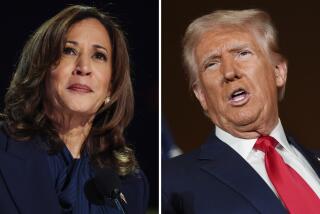Panel Close to Proposing Tax Overhaul
- Share via
WASHINGTON — The Senate Finance Committee edged gingerly toward approving sweeping changes in the federal income tax system Monday, strongly praising legislation that would tax four of every five Americans at a 15% rate and exempt 6 million low-income people from paying taxes altogether.
After questioning congressional and Treasury Department experts for three hours at a committee hearing, some panel members voiced concerns about the plan, which abolishes many deductions and tax shelters but gives the average citizen a 6% tax cut and caps corporate levies at a 33% rate.
But Chairman Bob Packwood (R-Ore.) said his panel is “clearly very close” to approving the tax overhaul bill, a view echoed by some of Monday’s more vocal skeptics on the finance panel.
Dole Expresses Optimism
Sen. John Heinz (R-Pa.), who criticized the legislation’s treatment of individual retirement accounts and other pension plans, later said he was “very close to supporting” the measure. Senate Majority Leader Bob Dole (R-Kan.), stopping short of endorsing the legislation, nevertheless told reporters that it is “looking better.”
One of the bill’s strongest backers, Sen. Bill Bradley (D-N.J.), said that the measure’s lowered tax rates make it “the most significant piece of legislation to benefit low- and middle-income people . . . in the last 20 years.”
Packwood, working against a self-imposed deadline to prepare tax legislation for a full Senate vote by June, held a long evening session for his panel to work out details of the bill.
Would Scrap Loopholes
The legislation, perhaps the most radical of several tax measures proposed in the last year by the White House and its Democratic critics, scraps the current maze of tax brackets, deductions and so-called loopholes in favor of a simpler two-tier system with only a handful of tax breaks.
Under the proposal, personal income would be taxed at a 15% rate up to a taxable income “break point” of $17,600 for individuals and $29,300 for those who file joint returns. After that point, a 27% rate would apply. For the highest-income taxpayers, the 27% rate would apply to all income, including the first $29,300 for those who file jointly. That rate would apply to couples earning $87,000 to $240,000 and individuals earning $75,000 to $145,000.
The standard deduction, now $2,480 for singles and $3,670 for couples, would rise to $3,000 for singles and $5,000 for those who file jointly. And a personal exemption of $2,000, also phased out for wealthy taxpayers, would be introduced by 1988 to replace this year’s $1,080 exemption.
The plan would finance the lowered tax rates by wiping out about $50 billion in tax shelters now used by upper-income Americans and by collecting an additional $93 billion to $103 billion from corporate tax changes. In addition, it would end popular deductions now used by many taxpayers, including those for sales taxes; miscellaneous expenses, such as union dues, and IRAs when a taxpayer is covered by another pension plan.
Minimum Corporate Tax
The corporate changes would lower the maximum tax rate to 33%, compared to the current 46%, but they also would institute a minimum tax, abolish investment tax credits and make other accounting changes that would increase overall revenue.
Several panel members promised Monday to try to preserve deductions for IRAs and sales taxes--two big-ticket items in the bill that would provide about $45 billion in increased revenue over the next five years.
Sen. George J. Mitchell (D-Me.), arguing that a 27% maximum tax rate is too low for the wealthiest taxpayers, said he will seek to tack a third, higher tax bracket onto the legislation when and if it reaches the Senate floor.
But there was surprisingly little protest against the measure in the Finance Committee hearing. Packwood later said he was pleased by the lack of “antagonistic” behavior among the panel’s members.
More to Read
Get the L.A. Times Politics newsletter
Deeply reported insights into legislation, politics and policy from Sacramento, Washington and beyond. In your inbox twice per week.
You may occasionally receive promotional content from the Los Angeles Times.










